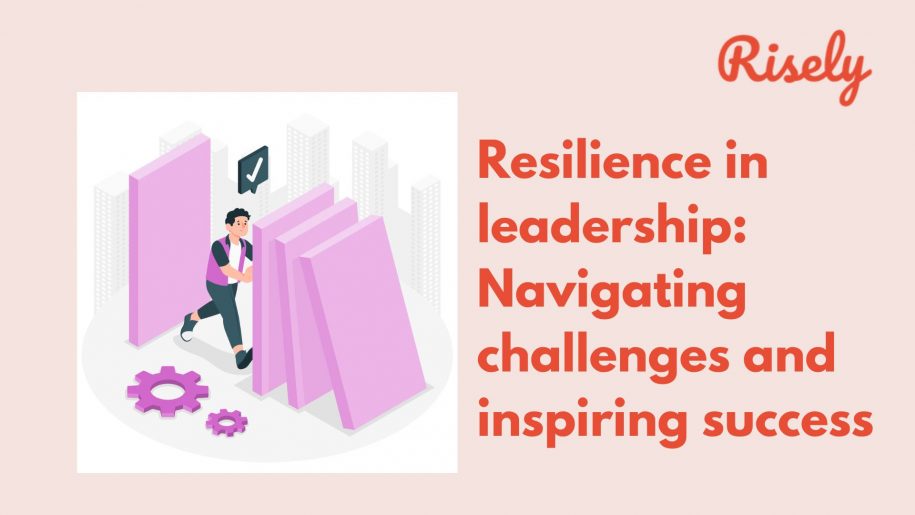Resilience in leadership: Navigating challenges and inspiring success
Picture a leader who navigates through storms of uncertainty, adapts to unforeseen challenges, and inspires their team to rise above adversity. They possess an unwavering determination that fuels their ability to bounce back from setbacks and emerge stronger than ever before. This trait is not simply a personality characteristic but a skill that can be cultivated and honed. In this blog, we talk about the realm of resilience in leadership and uncover the secrets behind its importance and impact. But why is resilience in leadership so important? We’ll uncover the tangible benefits of resilient leadership. We’ll also explore the blockages that can impede the development of resilience in leadership.What is resilience?
Resilience refers to the ability to adapt, bounce back, and recover from adversity, challenges, or setbacks. It involves maintaining a positive mindset, managing stress, and effectively coping with difficult people and situations. Resilience enables individuals to navigate through hardships, learn from experiences, and emerge stronger and more capable of handling future challenges.What is resilience in leadership?
Resilience in leadership refers to a style of leadership that emphasizes the development and application of resilience within individuals and teams. It involves leading and guiding others in a way that promotes their ability to adapt, navigate change, and thrive in the face of adversity and challenges. Resilience in leadership recognizes that uncertainties, disruptions, and setbacks are inevitable in today’s complex and rapidly changing world. A resilient leader can effectively respond to these challenges, foster a culture of resilience, and inspire and support others to do the same.Characteristics and traits associated with resilience in leadership
- Vision and purpose: Resilient leaders have a clear vision and purpose that guides their decision-making and actions. They communicate this vision to their team members, inspiring them to stay focused and motivated during difficult times.
- Adaptability and agility: Resilient leaders are flexible and open to change. They quickly adapt their strategies and approaches based on evolving circumstances and new information. They encourage experimentation, innovation, and learning from failures.
- Emotional intelligence: Resilient leaders are aware of their own emotions and those of others. They possess strong emotional intelligence and can empathize with the challenges and experiences of their team members. They provide support, create a psychologically safe environment, and promote well-being.
- Communication and transparency: Resilient leaders promote open and transparent communication. They share information, provide regular updates, and encourage dialogue within the organization. Effective communication helps build trust, reduces uncertainty, and fosters collaboration.
- Building resilience in others: Resilience leaders invest in the development of their team members’ resilience skills and capacities. They provide resources, training, and support systems to help individuals and teams bounce back from setbacks, cope with stress, and thrive in challenging situations.
- Learning orientation: Resilient leaders encourage a culture of continuous learning and growth. They view failures and setbacks as opportunities for learning and improvement. They promote reflection, feedback, and a willingness to adapt and evolve.
Other Interesting Reads
Why is resilience in leadership important?
Resilience in leadership is crucial for several reasons:- Navigating uncertainty and change: Leaders must navigate uncertainty, volatility, and unexpected disruptions. Resilient leaders can effectively adapt their strategies, make informed decisions, and guide their teams through turbulent times.
- Overcoming obstacles and setbacks: Challenges and setbacks are inevitable in any endeavor. Resilient leaders can bounce back from failures, setbacks, or crises, maintaining their composure and inspiring their teams to persevere. They view obstacles as learning opportunities and find innovative solutions to overcome them.
- Fostering a positive and inclusive work environment: Resilient leaders create a supportive and psychologically safe work environment. They promote open communication, trust, and collaboration, which empowers team members to take risks, share ideas, and learn from mistakes. A resilient leader’s positive attitude and optimism can motivate and inspire others, even in challenging situations.
- Promoting well-being and managing stress: Leadership roles often involve high responsibility, pressure, and stress levels. Resilient leaders prioritize their well-being and practice self-care, recognizing that their ability to manage stress and maintain resilience directly impacts their leadership effectiveness. They also support their team members’ well-being, fostering a culture that values work-life balance, self-care practices, and mental health in the workplace.
- Facilitating change and innovation: Resilient leaders embrace change and drive innovation within their organizations. They encourage creativity, risk-taking, and learning from failures. By promoting a culture of resilience, they create an environment where individuals and teams can adapt to change, experiment with new ideas, and continuously improve.
- Building trust and credibility: Resilient leaders build trust and credibility with their team members and stakeholders. When faced with challenges, they display transparency, honesty, and integrity in their actions and communications. Leaders gain respect and inspire confidence in their abilities by demonstrating resilience and successfully navigating difficult situations.
- Developing future leaders: Resilient leaders invest in developing the resilience of their team members. They provide guidance, mentorship, and opportunities for growth, empowering individuals to become future leaders. By fostering resilience in others, resilient leaders create a legacy of strong leadership within their organizations.
Blockages to resilience in leadership
Various blockages or challenges can hinder the development and practice of resilience in leadership:- Fear of failure
- Lack of self-awareness
- Resistance to change
- Ineffective communication
- Lack of support systems
- Overemphasis on short-term results
- Burnout and work-life imbalance
Ways to become a more resilient leader
Becoming more resilient in leadership requires intentional effort and continuous development:- Develop self-awareness: Start by increasing your self-awareness and understanding your strengths, weaknesses, values, and triggers. This self-reflection allows you to recognize your emotional responses and thought patterns during challenging situations, enabling you to manage them effectively.
- Cultivate a growth mindset: Embrace a growth mindset, which involves viewing challenges as opportunities for learning and growth. Emphasize continuous learning, seek feedback, and view failures as stepping stones toward success.
- Build a support network: Surround yourself with a strong support network of mentors, colleagues, and friends who can provide guidance, encouragement, and different perspectives.
- Practice self-care: Prioritize self-care and well-being to sustain your resilience. Take care of your health through regular exercise, healthy eating, and adequate sleep. Engage in stress management techniques.
- Enhance emotional intelligence: Develop your emotional intelligence to better understand, manage your emotions, and empathize with others. Emotional intelligence contributes to resilient leadership by fostering collaboration, trust, and effective problem-solving.
- Embrace change and adaptability: Develop a mindset that is open to change and adaptable to new situations. Embrace innovation and encourage your team members to explore new ideas and approaches.
- Foster a positive work environment: Create a supportive environment that promotes psychological safety, trust, and open communication. Encourage team members to share ideas, take calculated risks, and learn from failures. Recognize and celebrate achievements, fostering a positive and resilient culture.
- Continuously learn and grow: Engage in continuous learning and professional development. Actively seek feedback and reflect on your experiences to identify areas for improvement.
Conclusion
Resilience in leadership is not merely a desirable trait but an essential quality that sets exceptional leaders apart. Throughout this exploration of resilience in leadership, we have uncovered its immense importance and impact. We have witnessed resilient leaders rise above adversity, inspire their teams, and navigate challenging times with grace and determination. We have seen that developing resilience in leadership is a journey that requires intentional effort and continuous growth. It starts with self-awareness, understanding our strengths, weaknesses, and triggers, and aligning our values with our leadership approach. As we conclude resilience in leadership blog, let us remember that resilience is not about being invincible or never facing challenges. Instead, it is about how we respond to those challenges and the lessons we learn. Resilient leaders embrace change, view setbacks as opportunities for growth, and inspire others to persevere through difficult times.Are your critical thinking skills sharp enough to help you grow through challenges?
Discover the hurdles that disrupt critical thinking with a free assessment now.
Frequently asked questions
How do you build resilience as a leader?
Building resilience as a leader:
– Cultivate a growth mindset and embrace challenges as learning opportunities.
– Develop self-awareness to understand your strengths, weaknesses, and triggers.
– Cultivate a growth mindset and embrace challenges as learning opportunities.
– Develop self-awareness to understand your strengths, weaknesses, and triggers.
What is an example of resilience in leadership?
Example: A CEO leading a company through a major financial crisis remains composed, communicates transparently with stakeholders, and takes decisive actions to stabilize the situation. They inspire the team to stay focused, make difficult decisions, and find innovative solutions to overcome the crisis.
What are the 5 skills of resilience?
– Self-awareness
– Optimism
– Adaptability
– Emotional regulation
– Problem-solving
– Optimism
– Adaptability
– Emotional regulation
– Problem-solving
Other Related Blogs
Building an Ultimate Leadership Development Action Plan
How to Build a Leadership Development Action Plan? Having a strong Leadership Development Action Plan is more critical than ever in today’s evolving business world. Whether you’re looking to drive…
Leadership Journey Examples on the RiseUp Radio Podcast
Leadership Journey Examples on the RiseUp Radio Podcast Leadership isn’t a destination – it’s a journey filled with twists, turns, and transformative moments that shape not just careers, but entire…
What is Immersive Learning? A New Era in Education
In this blog, you’ll learn what is immersive learning and how it is changing training, increasing engagement, and influencing the future of workforce development. … Read More
What are Learning Designs? All You Need To Know
This blog explains what learning designs are in depth while also covering it’s key components. It tells you about the process involved in creating a good learning design along with…


